Most Popular Fashion in 1950 for Men
Post-obit the Second Globe War, the world experienced rapid changes in many facets of life–including menswear! Today, as another installment in our What Men Really Wore series, we'll hop into our time machine to examine the fashions of the 1950s and determine the good, the bad, and the foreign.
When you think of the 1950s, you probably think of adept times – rock and ringlet and, of course, Elvis. Perhaps you think most the dawn of TV dinners or that the polio vaccine was invented. Fifty-fifty with all that positive energy, though, it wasn't enough to prevent the popularization of polyester! Although invented in the 1940s, the '50s were the decade where synthetic fibers in menswear spread like a plague.
With all that said, the '50s were certainly cheerier than the 1940s. It was the age of increasing comfort and convenience. The '50s also saw the nascence of the teenager and the rebellious youth, and the different fashions and styles that came along with it.
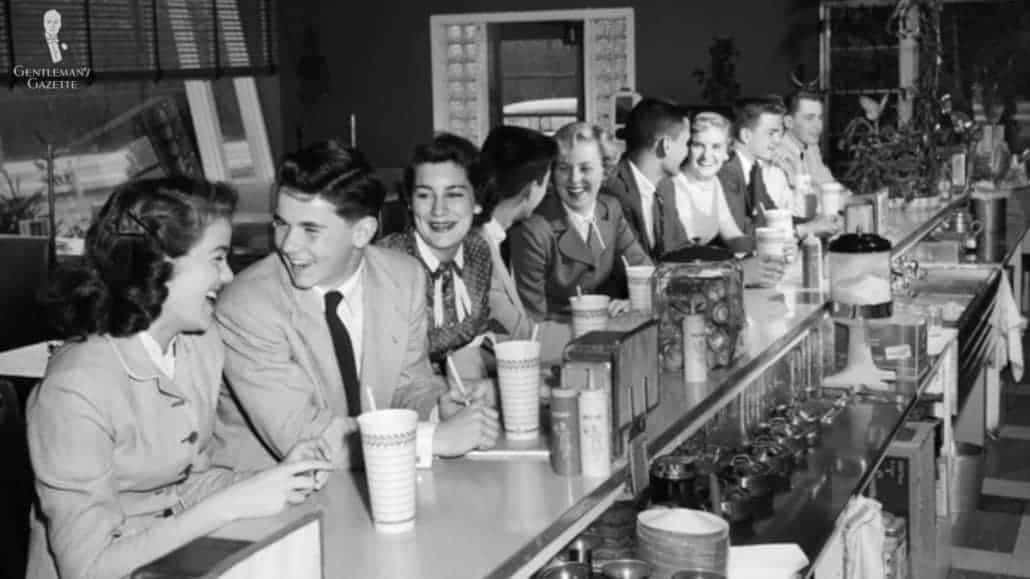
Later on all, Globe War II was over, rations had been loosened or abolished altogether, and it was time to focus on the nice things in life – travel, food, and, of course, fashion. With the prices of fabric rapidly decreasing, information technology was an opportunity for men to have more clothes, which too meant they at present had more casual apparel.
The '50s saw an explosion of coincidental clothes that were fueled past stars like James Dean, Dean Martin, Frank Sinatra, and Marlon Brando. Hollywood had divers the fashions since the '20s, and their agree over the public imagination grew stronger and stronger in the '50s.

What Men Really Wore in the 1950s – i. Hats
If other decades give u.s. any indication of what would happen to hat clothing, y'all might assume that they became less popular. Wrong! In fact, the '50s saw a resurgence of lid article of clothing. Responsible for this renaissance was the fact that men now could dress upwards over again and vesture something they liked, instead of a uniform they had to wear.
Some would continue to wear the fedora, but a lot of other styles were available at their disposal now. In the summertime, some may sport a boater or a Panama hat, or a straw hat.

Flat caps are around, people wore them for sports or for a more casual look. Only, they were a lot more streamlined and less voluminous than the earlier models.
In my mind, the biggest matter that happened in the '50s was color. There was a lot more color in menswear, which I think was positive. In previous decades, hats used to exist black or grey or possibly navy. Now, men were enjoying hats in all different hues.
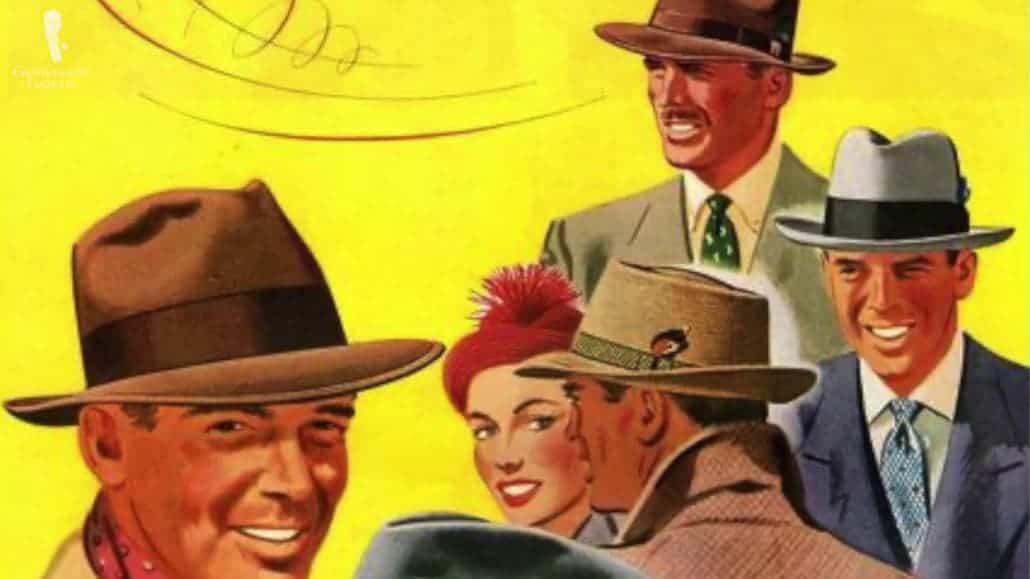
They as well upgraded the hatbands, sometimes adding bird feathers, for more than individualization and colour or different pleats. Basically, hatbands in hats were somewhat an outlet for creativity.
2. Hair and Facial Pilus
Much similar the 1940s, pilus was very important in the '50s. Yeah, I just told you men did wear hats, merely some skipped them and that was okay. They focused more on their hair and their style. Overall, hairstyles were bigger and more complex than in previous decades for men.
To attain those glorious and waxy hairstyles, you utilise something chosen pomade. Yous may recollect Murray's or Sweet Georgia Brown.


That stuff's still around today, but it tin rub off on your head in your hatband or your pillowcase or annihilation else that touches your head. In fact, for me, when I used it, I got a whole lot of pomade acne, which is terrible. So, I stopped using it.
Men back so would typically have a comb with them, so they tin can become the hairstyle they want and touch upon it no matter where they were.
Popular 1950s hairstyles were the pompadour, the jelly ringlet (also known equally the duck's arse), and the slick-back. The pompadour was brushed astern and stood high to a higher place the forehead. If you've seen pictures of Elvis, you've likely seen that style before. It was pretty popular with the rock-and-scroll scene at the time.

The jelly roll was achieved by crimper the pilus along the side all leading to a point in the centre front end. This manner was taken to the extreme past The Teddy Boys in Britain and, because of that, it was probably immortalized and heavily associated with that group.
The slick-dorsum style speaks for itself. Men like Cary Grant would wear information technology. It typically came with a side part. The side of the caput was a scrap longer than what you see in, maybe, Peaky Blinders or in earlier styles.


In terms of facial pilus, nearly men were shaven in the '50s. A youthful, sporty yet masculine appearance was important. And and then, youthfulness was associated with a shaven look. Older men still sported beards and, some of them, even moustaches.
James Dean, on the other manus, popularized the somewhat rougher, less-shaven expect with a flake of stubble, which was a novelty at the fourth dimension.

iii. Eyewear (Eyeglasses & Sunglasses)
Thanks to the pic stars, sunglasses had really get a symbol of wealth and fashion. Really, they served a practical purpose, but information technology was much more about glamour and representing success. Of course, the sunny climate in California helped Hollywood to shoot movies outside and so, sunglasses came in handy. Considering of that, the buy of sunglasses rose significantly in the 1950s.
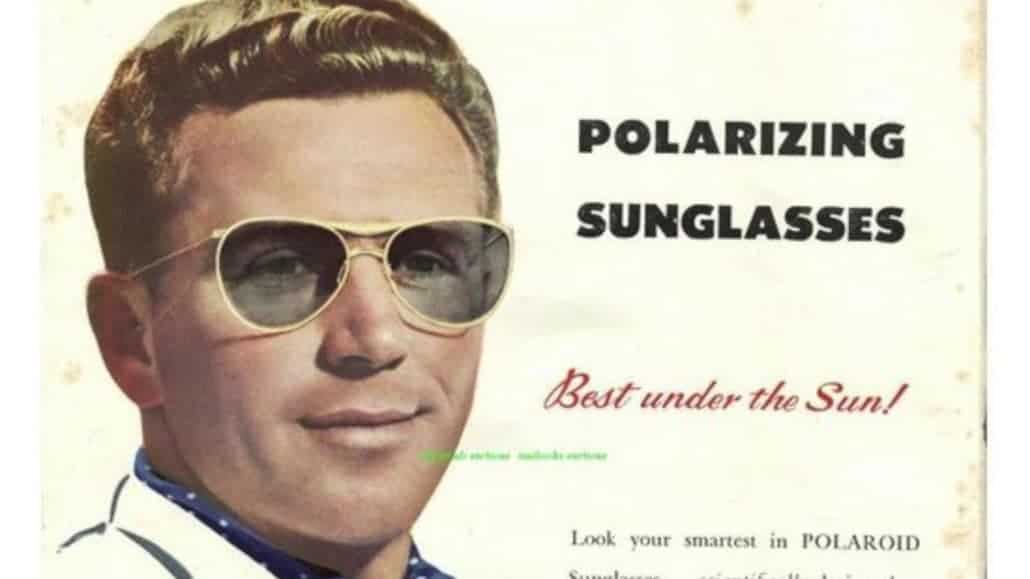
For women, the famous style was a cat-heart manner every bit popularized past Audrey Hepburn. For men, spectacles took the shape of a thick-rim plastic frame, as inspired past Hollywood actors and icons at the time, such as Buddy Holly or Phil Silvers.
Browline glasses were also all the same popular at the fourth dimension and, more importantly, they could come in different colors. Black, blue, orangish, imitation tortoiseshell, or fifty-fifty articulate frames were seen on men in the '50s.

4. Waistcoats (Vests)
And so, what happened to the waistcoat in the '50s? Well, it wasn't as essential anymore as it was in previous decades for the business suit. And so, some men skipped it.
Young men, especially aspiring young men, would wear the belong. However, they would often wear a contrasting vest and it could be contrasting the fabric. For case, a knit vest in a unlike colour or a wool doeskin skin vest.
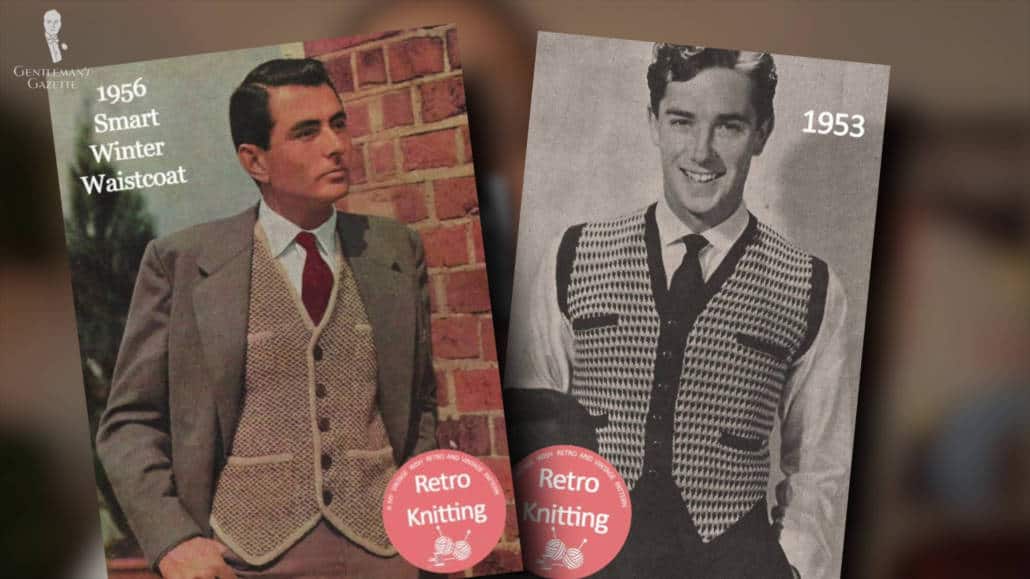
Some waistcoats had lapels, others didn't, some had two pockets, others four. Overall, if you wore a waistcoat, information technology was a style pick, not a necessity for heating purposes. A very few select men would proceed wearing the three-piece accommodate with a matching belong. But, it wasn't as popular during the '50s.
five. Shirts & Collars
Past the 1940s, the shirt collar had now firmly evolved to be attached to the shirt, unlike in the 1920s or 1910s. Detachable collars were hardly effectually anymore and only reserved for special evening functions, really. Recall about Black Tie, White Tie, or morn article of clothing. And even then, it was perfectly acceptable at this time to wear a soft plough-on collar with your Blackness Tie tuxedo ensemble.
The few men who chose detachable collars typically wore plastic collars or trubenized collars from the 1940s.
There'southward a mode in the '50s, some sort of a revival of the order collar with rounded corners. Other than that, the spearpoint collar was still effectually and then was a collar with shorter points. Because the collars were softer than before, most of them were buttoned down or they had a tab or y'all all the same wore them with a neckband clip or a neckband pivot.


Initially, in the '50s, shirt colors were assuming. Only, as the decade went on, they became more than pastel, less extreme, both in color and in pattern. But, overall, a more humble arroyo was taken towards business wear, towards the latter part of the 1950s. Some may debate that the shirt just got quieter. Then, the ties could polish more in all their colorful brightness.
Some men notwithstanding wear cufflinks, but the barrel cuff had become actually popular at the fourth dimension. And because the waistcoat was often gone at present, you'd detect at least i breast pocket on the left side of a shirt.
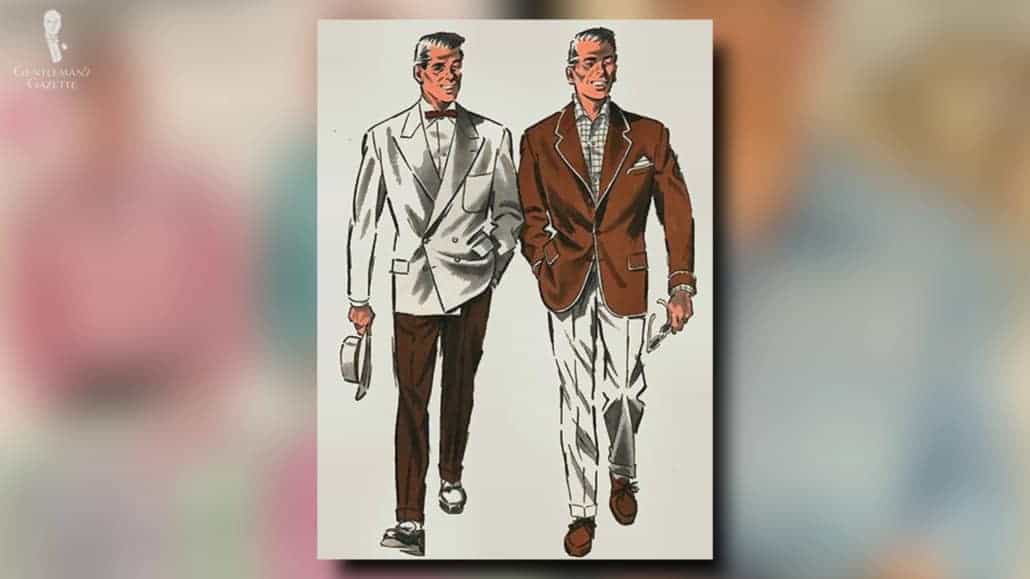
The '50s had its off-white share of assuming colorful ties. Yet, in the aforementioned decade, y'all could wear a suit every bit a homo without having to wear a tie or a bow tie. That meant leaving your shirt unbuttoned or wearing a shirt with a campsite neckband that wasn't meant to be buttoned in the first place.
Typically, the top button was undone, maybe the top two; unless yous were James Dean, then yous could button up your shirt a lot further down. And, as we had talked about in our other guide, James Dean was quite an iconic man of manner in the '50s, and his mode is being emulated upward to this day.
Coincidental Clothing
The '50s began the spread of casual clothing. Casual dorsum then didn't hateful what casual means today. Considering of the lowered prices for fabric, such as polyester, men were able to afford more than wearing apparel. That meant they didn't simply accept to buy wearing apparel shirts. They could besides have a Hawaiian shirt or a T-shirt, and just have a broader approach to clothing in general.
I mean, honestly, the whole T-shirt manner and craze that lasts on to this day started in 1951 with Marlon Brando in the movie "A Streetcar Named Desire." In that motion-picture show, Brando famously wore his undershirt with nothing on acme of it. Back in the twenty-four hour period, they must have felt like someone merely showing up with their underwear.

Back to casual shirts, then. They had stripes, colorful checks, and geometric patterns. Even corduroy, in a kind of fine wale cord, was pop. This started due to the popularity of knit shirts, which were more popular during the colder months of the twelvemonth.
Some other form of the shirt that was rather pop dorsum and then was the gaucho, which is the word for a South American "cowboy." The gaucho shirt was, simply put, a pullover shirt that had an open neckband. The verbal spread of the collar would change throughout the decade, depending on the preferences of fashion. The open collar was typically fastened with a cipher or with a button and a loop.

Depending on how casual the occasion was, men could wear their military camp collar shirts, sometimes untucked. In that case, the hem was cutting straight all around. And, sometimes, they had side pockets at the bottom as you would, maybe, know them from pajamas, which we tackle in another guide.
half-dozen. Neckties & Bow Ties
Ties were still widely pop, fifty-fifty at the workplace. Only, some opted to go without them and information technology was okay. In terms of sizes, typically, you lot had one for wider spread collars that was about three and a one-half inches wide, then a slimmer width about two inches for narrower collars. Most ties were tipped now, dissimilar in the '30s where most ties weren't. Only, of class, you could all the same find untipped ties.
Fifties' ties came in a huge variety of patterns and colors, including middle medallions or center patterns, which were much harder to produce because, if y'all take something printed on a necktie, it has to be centered at the top and the bottom. Nada can shift towards production. So, they're much harder to produce than, a polka dot or a geometric pattern that is the same all over the tie.

That existence said, abstract patterns, fantastical patterns, likewise every bit geometric patterns in bold colors and multi-colors were popular.
The material range was rayon, polyester, silk, wool, or even cotton. Also, men did wear knit ties in the '50s. Towards the later part of the '50s, ties, just like shirts, toned down a bit. The patterns became less extreme and so did the colors.
Bow Ties
Aye, men still wore bow ties, and at the very showtime of the '50s, the bow tie was bigger and wider. Towards the mid-50s, the bow tie had become quite slim and a niggling longer, which was a typical 1950s await.
In the '40s, things were shorter and fatter. Then, the '50s bow ties are very characteristic when you watch an quondam movie or one-time photos. Too, it seems like the colour range of bow ties in the '50s was actually expanded. Previously, black was popular, maybe navy with polka dots. Merely, now, yous had pastel tones and patterns in colors like chartreuse and ochre.

While cocky-necktie bow ties and neckties were still a standard, some men felt it wasn't convenient enough. They didn't know how to properly tie a necktie. And because of that, you find all these clip-on bow ties or tuck-on bow ties or any it is.
There was no standardized mechanism. Some had a band that was rubberband around it, others just an open claw. But, the overall idea of not tying your own neckwear became firmly established in the 1950s. How convenient! Information technology must be said, though, that nothing makes you look more like a schoolboy than a pre-tied necktie or, especially, bow tie!

We put together a footstep-by-footstep guide that explains how to necktie a bow tie the piece of cake way for beginners. If you follow it, you tin do it. Information technology'south fairly simple. It's really like tying your shoe. Only on your neck. It takes a little practice, but well-nigh everyone tin can practise it, including y'all.
And if you're not certain well-nigh tie knots, we put together pop necktie knots with hands-on, easy step-by-step tutorials that y'all can follow, and then you never have to wear clip-on ties or bow ties.
seven. Suits, Sport Coats, & Leisure Jackets
Early in the decade, you still constitute a typical American sack suit – no forepart darts, cut very direct, and baggier with a center vent. Lapels were a chip narrower. There was also a bit less shoulder padding. The buttoning signal was quite a bit lower and the bottom button on a single-breasted jacket usually sabbatum in line with the pockets.
Overall, suits were rather bourgeois. The most pop colour was probably grayness, but you could also find blacks or browns or navies in suiting. Generally, the mid to late-50s was a very somber time and nosotros typically saw a gray conform with a white shirt.

Frankly, I have tons of tailoring magazines from the '50s from Germany. And if you await at those suits, they all await very chiseled. There is no wrinkle anywhere. And then, they used heavier fabrics. They withal had horsehair interlinings, floating canvass, but much stiffer than what yous're used to these days from Naples, for instance.
Fabrics were wool or flannels, simply people besides liked mohair. If you're not familiar with information technology, information technology'due south an expensive fiber. It is often blended with wool for evening wear considering in that location'due south a sparkle. Information technology actually is much more fibroid than wool. It'due south not soft at all. Merely, information technology doesn't wrinkle and it's a cool cloth. I similar it!

Double-breasted jackets were around in the '50s, but single-breasted ones were more popular. In line with a single-breasted jacket, the double-breasted jacket had a low buttoning indicate. The lapels were a bit wider, simply non too wide. The tips were oftentimes rounded or more heavily rounded than you lot might run across today.
The tardily '50s saw the emergence of the more than "continental style" or Roman-style adapt which was invented past Brioni. Brioni is still around today even though under dissimilar ownership. But, back then, it was founded by Gaetano Savini and Nazareno Fonticoli in Rome.
They had a very distinct style. It was narrower, unlike the American sack-fashion suit. Information technology had darts, it was a bit shorter, it had all the hallmarks of the traditional tailored arrange, and it became really popular with elegant men.

Also, the American sack suit typically had a center vent, whereas the Roman-style jacket had side vents. And if you look at jackets today, most jackets still have side vents. That goes back to that period of time with a Roman-way accommodate, where this became just much more pop.
Besides, the original Roman jacket ofttimes had more than elegant jetted pockets, not flat pockets. And, oftentimes, they were slightly angled to create a more dynamic look.
Leisure Jackets and Sport Coats
Of course, the adapt jacket was just one matter. The '50s was also the decade of the leisure jacket. Yes, to the part, men would however clothing more often than not suits, but once they were home, they wore more comfy stuff. Recall of a cardigan or a jumper or sweater. That was rather popular.
Typically, they had bright colors in dark-green. They sometimes had multiple colors knitted into them, and, once again, colour was a big thing in the '50s.
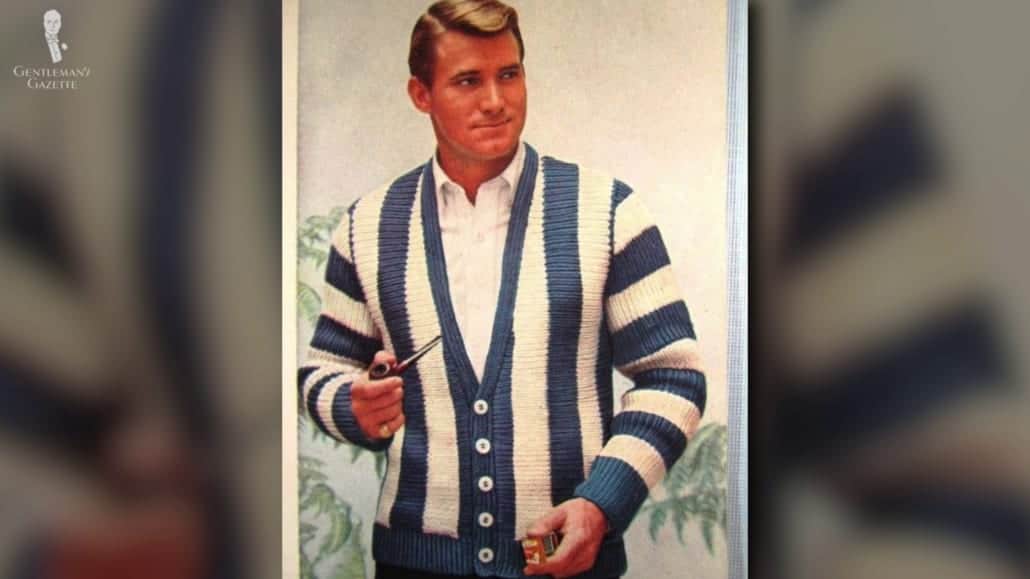
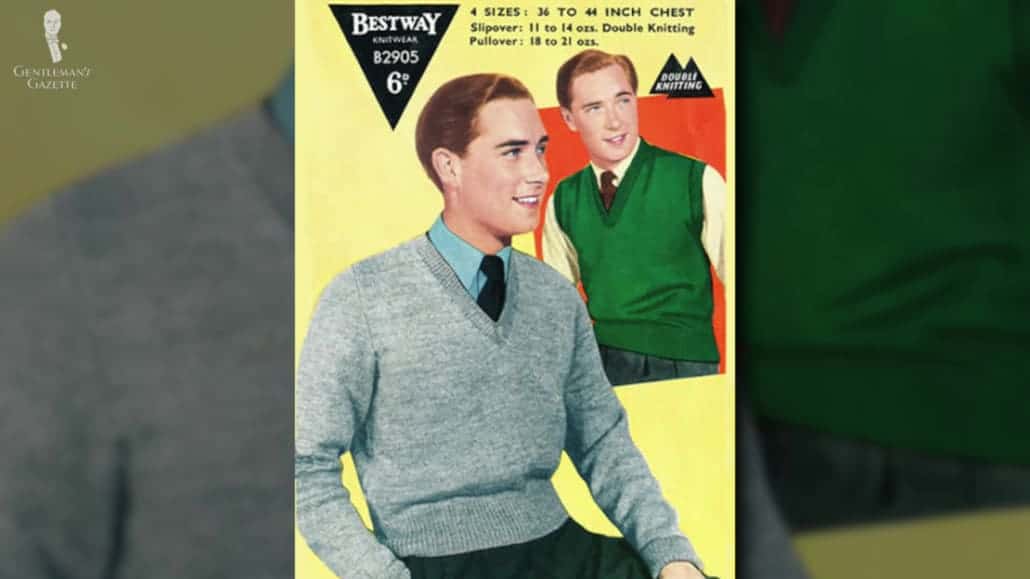
If y'all weren't just dwelling just yous would leave and about at a non-work function, oft, men would start wearing sport coats. These were jackets that had more coincidental features such as patch pockets. They were in colors that were bolder, tartans or plaids, or merely something that was more fun and more outgoing than the typical somber business accommodate.
I mean, in that location were lots of variations – two, 3, four buttons, little details, and changes, but nearly of them would have patch pockets and accept a two-push style.

A Word on Youth Culture
In America, there were several rebellious youth groups. One of them was the jock, the other popular one the greaser. And on the other side of the pond, there was the teddy boy.
Jocks
The jock was a typical cool child in high schoolhouse who was part of the sports squad. He would article of clothing a varsity jacket, which meant it was a wool trunk with leather sleeves. It also had sports or school logos embroidered or an keepsake on it. Typically quite large, it basically was a badge of honor that signaled that they were an achieved sportsman or simply part of a team.

Greasers
The greasers, on the other hand, were typically men that wore big hairstyles with leather motorcycle jackets, white t-shirt, and jeans. They were extremely rebellious to the idea of the quiet 1950s life.
It is said that Stanley Kramer was inspired past a small motorcycle gang when he came upwardly with the idea for the picture show "The Wild One." This picture, forth with "On The Waterfront" from 1954 and "Rebel Without A Crusade" from 1955, really made this whole style more established with America'south youth. James Dean, Marlon Brando became icons and even Elvis wore part of that greaser-way stuff.

Then, what did greasers wearable on their feet? Well, actually, some of them were Converse shoes, which used to exist the gym shoes, which are now more acceptable in casual wear, or they wore leather biker boots.
Teddy Boys
Across the pond, things were very dissimilar. The youth rebellion there took on a pseudo-Edwardian take with their large jelly-rolled pilus, lovingly called the "duck's arse." They wore interpretations of frock coats or drape jackets that were sometimes trimmed with velvet. Paired with a waistcoat, picket concatenation, bow tie or bolo tie, and brothel creeper shoes, the outfit was perfect for the Teddy Boy.

So, what are creepers? Well, brothel creepers or creepers are somewhat coincidental shoes, ofttimes with a suede upper. But, information technology can also exist in a smooth leather with a characteristic thick crepe sole. Typically, they're very low rise and non anything I would article of clothing today.
8. Trousers & Shorts
Trousers haven't changed too much since the '40s. They were still cut wider than trousers today with hem, on average, beingness about nine and a one-half inches wide open.
Many trousers notwithstanding featured two pleats, simply you could also find flat-front pants now. Some trousers were uncuffed, but you would see a lot more than cuffs in the '50s. And, typically, they were two and a half inches or about half dozen to six and a half centimeters tall.
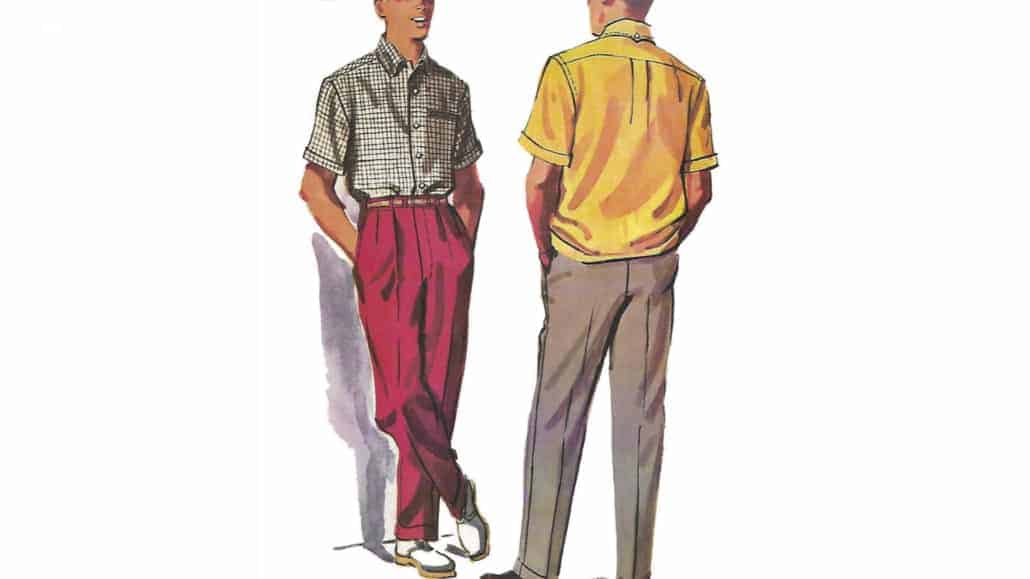
On some sporting trousers, the cinch belt in the back even fabricated a comeback, just it was brusk-lived.
Men in the '50s did non simply wear trousers, but they likewise wore shorts. Often, they were pleated and pretty much cutting like a pair of dress trousers, but they had bolder patterns – plaids, tartans, checks – in bolder colors.

In full Bermuda fashion though, you lot would wear them with over-the-dogie socks. Yes, knee-high socks. Merely like in the Bermudas!
9. Shoes (Formal & Coincidental)
The typical Oxfords and brogues in black, dark-brown were still around. Sometimes, you could also find white or off-white shoes that were popular and and so were saddle shoes.
Perhaps the strangest part of 1950s footwear is the "winklepicker," which is a very pointed shoe that looks pretty odd. It's probably slap-up for digging holes in the garden, but there is a reason this fad was short-lived.

A '50s shoe trend that survived until today is the chukka boots, which we take a defended guide to. Nosotros also reviewed the Clarks' chukka boot, which has become synonymous with the chukka kick itself.
Once more, color was a big thing in the '50s and that was part of the shoes. Elvis, for instance, popularized the blue suede shoes. It'south non so popular again today, but dorsum so, you could totally vesture that.

Let's also not forget that leather slippers became really popular around your home. They were padded a little more and were comfortable.
ten. Overcoats
Overcoats in the 1950s were interesting. Oft, they were single-breasted, sometimes as well double-breasted. Just, overall, they were cutting much wider and baggier. Also, they were cut from heavier fabric, so they would drape nicely.
Colors were brown, gray, or blackness, simply their fabrics had a much larger color depth, frequently by adding multiple colors into the weave, therefore assuasive you to wear it with all sorts of color in your lid or your pants or your shoes.
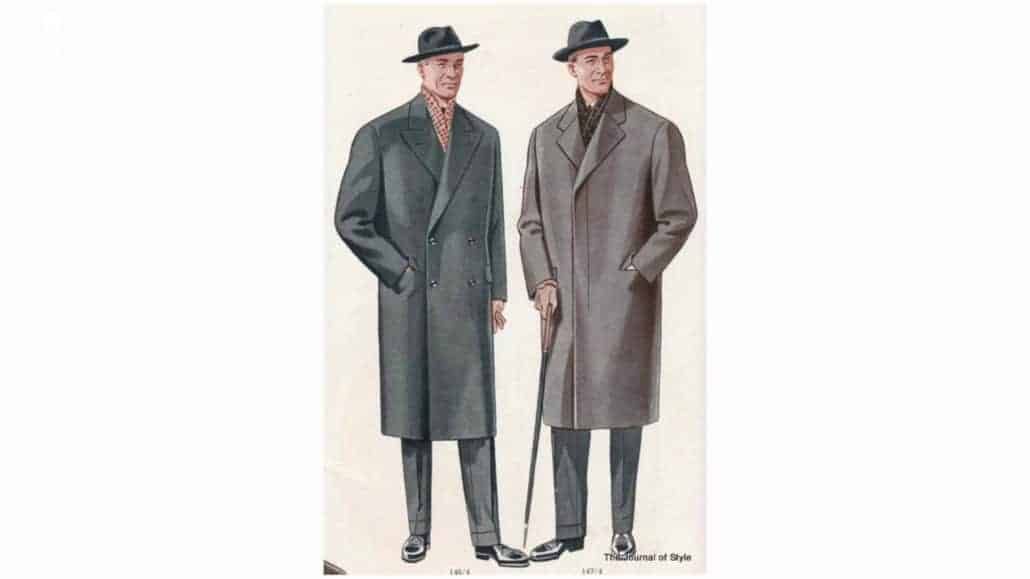
In terms of popularity, yous see a lot of double-breasted overcoats in photos and videos, but y'all tin as well spot single-breasted ones. If they were double-breasted, they typically had large patch pockets. Personally, I'm a big fan of double-breasted overcoats because, when it's cold outside, y'all want that double overlapping layer of material because that keeps you warm.
Some other popular overcoat seen in the '50s was the Ulster, besides as the Paletot overcoat.
xi. Accessories (Belts, Scarves, & More than)
Last but non least, let's expect at the 1950s accessories. Belts were a lot more popular than suspenders. Also, woven leather belts were just interesting colors and changes were something that men would article of clothing at the time. Coupled with unique-looking belt buckles, it really was a manner for a man to express his individuality.

Wearing a scarf too known equally a "muffler" was definitely something virtually gentlemen would do during the 1950s. Men would also wear gloves during the winter, which were nice leather clothes gloves in bolder colors.
In our Fort Belvedere store, yous can find gloves that are more interesting in color than the usual gloves, and the same with scarves that are double-sided. Very much in line with what the '50s were about – an increase in color and expression of individuality.

The aforementioned was true for socks and pocket squares. They were a flake bolder than in previous or following decades.
Decision
The '50s were a colossal decade for men's way because a lot of color came back, a lot of casual items came into fashion, and that was entirely new compared to previous decades. It likewise helped that consumerism was booming – people were willing to spend and they wanted to savor themselves again.
Honestly, there'due south such a wide range of clothing out of the 1950s. Information technology was hard to press it all into this guide, but I hope nosotros've given yous a good enough overview.
Outfit Rundown
I am wearing a bold pair of tartan plaid trousers in light-green, navy, white, ruby, and charcoal. My polo shirt is white and simple. I don't have one with a breast pocket; otherwise, I would have worn that. Merely, this is modern. Information technology is not an original 1950s vintage. My belt is woven with some leather and a gilded brass buckle and I'm pairing it with a pinky ring that also has a bloodstone in red and dark green, picking up the colors of my shorts.
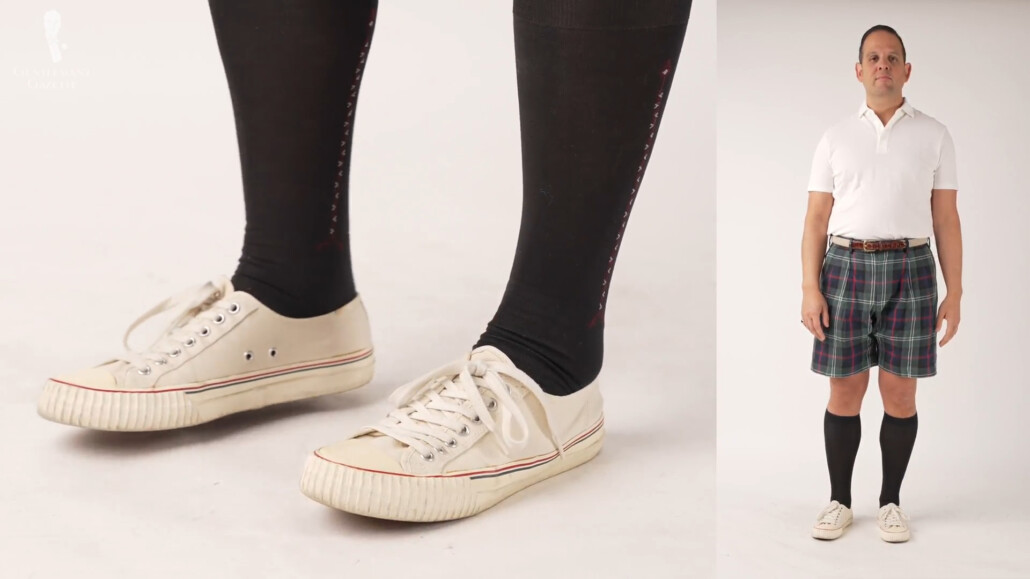
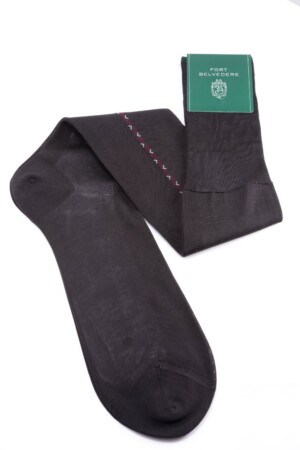
Fort Belvedere
Dark Grey Socks with Burgundy and White Clocks in Cotton
I am wearing them Bermuda-manner with a pair of over-the-calf socks. I opted for a charcoal pair with clocks. It's a solid color with a little pattern and I'm wearing a pair of PF Flyers, an fair color that matches my chugalug. They are very like to Converse shoes. They have this thick safety sole or a sail-manner sneaker. Lots of eyelets. And, overall, rather casual.
If you're interested in loftier-quality over-the-calf socks, such as the pair I am wearing, you lot tin can find them in our shop here.
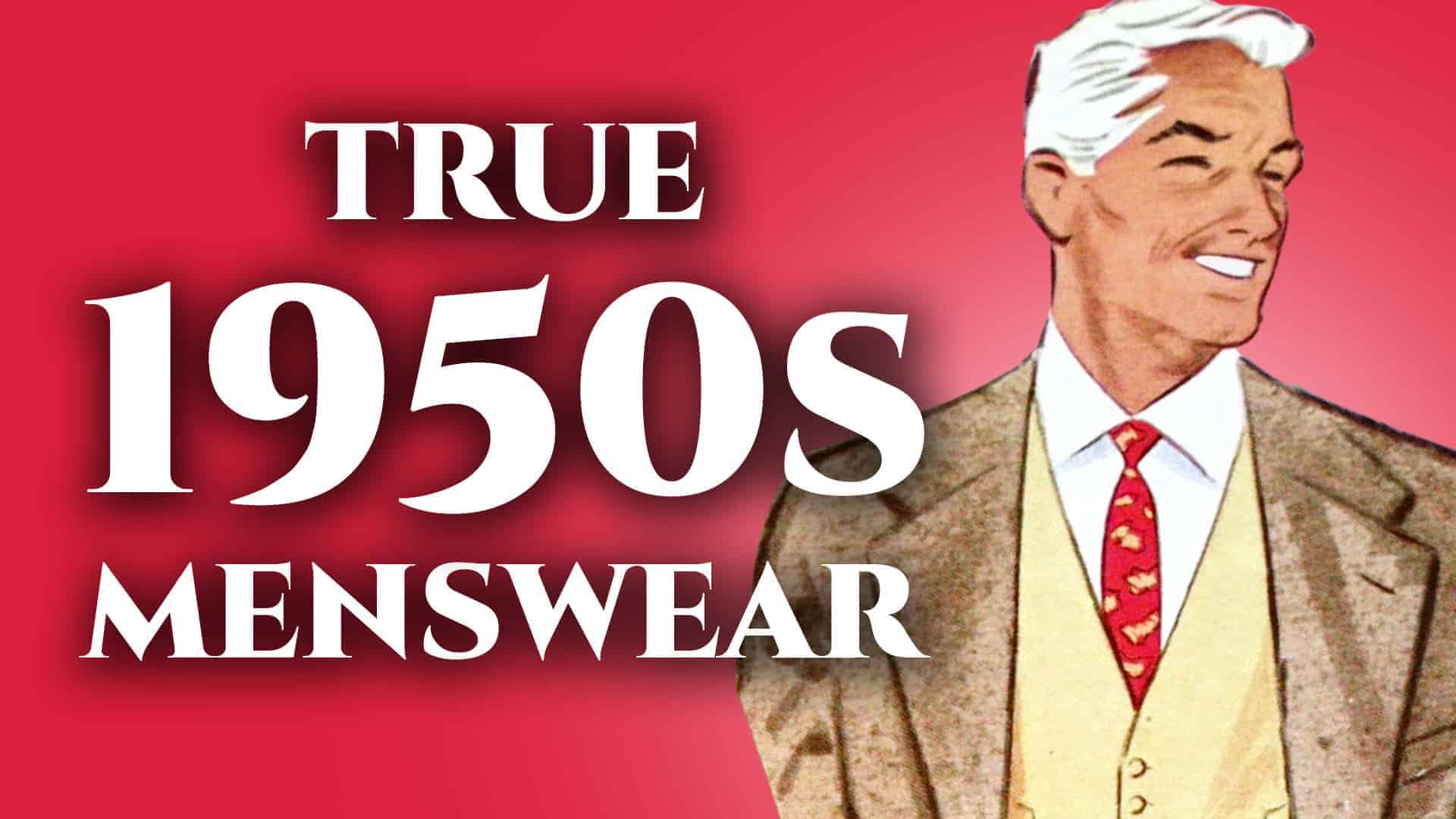
0 Response to "Most Popular Fashion in 1950 for Men"
Post a Comment